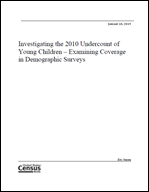Investigating the 2010 Undercount of Young Children – Examining Coverage in Demographic Surveys
Investigating the 2010 Undercount of Young Children – Examining Coverage in Demographic Surveys
Introduction
The estimated net undercount for young children, age 0 to 4, in the 2010 Census was 4.6 percent compared with a 0.1 overcount for the total population (Griffin 2014). The net coverage error for young children was even higher for some race and ethnic groups. The undercount of young children in the decennial census is a persistent problem that has been documented by demographers for many decades (See for example, Coale 1955, Table 7). Recent estimates show that the net undercount of young children in the 2010 Census was driven by 2.2 million omissions for young children (U.S. Census Bureau 2016a). In other words, one out of every ten young children were not included in the 2010 Census.
In 2013, the Census Bureau organized a task force on the undercount of young children, and a research team was created in 2015 to analyze this issue. While the focus of the task force and research team has been on the coverage of children in the census, we also wanted to evaluate the coverage of this population in demographic surveys.
There are reasons we would expect demographic surveys to have patterns of coverage similar to the census and other reasons why we would expect demographic surveys to have different coverage patterns from the census. Some demographic surveys and the census ask respondents to create a roster of household members (Tourangeau et al. 1997). Surveys and the census both include operations to address nonresponse and increase overall participation. However, surveys have less extensive nonresponse follow-up and coverage improvement procedures, may have a panel or longitudinal design, are often collected throughout the year leading to seasonal variation in coverage, and do not have the same level of marketing and advertising as the decennial census.
Coverage in a survey is measured by calculating the relative coverage rate, which is the ratio of the uncontrolled survey estimate for a population to an independent population estimate. Many of the demographic surveys conducted by the Census Bureau use data from the Population Estimates Program as survey controls to adjust for coverage error. In other words, survey results are weighted to make sure they are consistent with the population estimates. The Census Bureau’s Postcensal Population Estimates use the most recent census counts as the base population and then account for births, deaths, and migration since the census to provide current population estimates. The population estimates are produced by age, sex, race, and Hispanic origin. The coverage rates for the surveys can be calculated for these same characteristics, but not for additional characteristics such as poverty status or household structure.
In this report, we analyze coverage rates by age, race, and Hispanic origin for the American Community Survey (ACS), Current Population Survey (CPS), and the Survey of Income and Program Participation (SIPP).
These surveys have different sample designs but are each controlled to the postcensal population estimates, which allows us to calculate relative coverage rates. As stated above, the population estimates are based on the decennial census, which undercounts young children. To address this issue, we use data from 2009 and from 2015, when available. In these years, the population age 0 to 4 would have been born after the previous census, therefore, the population estimates for this cohort were developed primarily from vital
statistics data on births and not census counts. We then calculate adjusted coverage rates for the cohorts where the population estimates are based on the census to account for coverage error in the census. This allows more legitimate comparisons across age groups.




